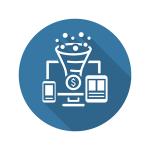
When someone gets an email via LinkedIn that says “John Smith has sent you a new message,” there are few possible outcomes. The recipient could be quick to open it and reply as they would any other kind of email message. They might ignore it (particularly if they’ve changed their settings not to have LinkedIn message notifications). Or, in the worst-case scenario, they could delete the message or report it as spam and remove the connection who sent it.
This is a lot like the sales and prospecting process in many other channels such as phone calls or traditional email. The big difference is that LinkedIn in particular was designed for business users in mind. That doesn’t necessarily mean it was designed for selling, but for relationship building—which of course, could turn into something transactional at some point.
Most experts will suggest using mutual connections to get introduced via LinkedIn. Then, once you’re connected, to start sending InMail (LinkedIn’s built-in email system) to send tailored messages to move a sales conversation forward. That can certainly work, but it’s not the only way to “cold call” on the platform. It may be best to think of this as a journey, rather than a quick-and-dirty sales tactic.
1. Understanding The Landscape
If you’ve been out of work in the last few years, you’ll recognize immediately what LinkedIn is primarily focused on, which is recruiting and making it easier for people to market themselves for career opportunities. In fact, many online job applications now often feature an “upload LinkedIn profile” in lieu of a traditional resume.
As obvious as it sounds, it’s worth underscoring the fact that what motivated most people to join and develop their profile on LinkedIn was self-interest. They were not necessarily interested in opening themselves up to being contacted by sales or marketing professionals. The details they post publicly—their skills, their interests, their responsibilities—can be a gold mine of prospecting data, but only if used in subtle ways.
More specifically, bear in mind that many people keep track of the “Who’s Viewed Your Profile” feature. In other words, if you’re researching a potential client, they may be aware of your interest before you reach out, so something that acknowledges that fact (ie, “You may have noticed I was reviewing your profile”) should probably be folded into your initial outreach.
2. Follow Before You Connect
Unless you get introduced via a mutual connection, LinkedIn does not allow you to communicate with others on its service. That doesn’t mean you can’t be a part of their activity on LinkedIn, however. It’s possible to “follow” LinkedIn accounts and see their public status updates appear in your feed. Followers can make comments on these status updates, which can be an effective way of weaving yourself into their social media dialogue and providing your own insights. If your comments are valuable or if you like and reshare their status update, they may be more likely to respond a connection request when and if you make one.
3. Look For Group Discussions
Before you spent hours looking for mutual connections and angling for an introduction, the fastest way to get connected to a prospect on LinkedIn is to belong to one of the same groups they are. In many cases, this is very easy to do, and gets around the challenge of having to have done business or have worked for the same employer as that prospect. Look at the groups they belong to on their profile and join the ones where it makes sense. For example, look for a group about an industry in which you both work, or that focuses on a similar job level or role (like the many groups for CEOs or managers, for example).
Next, take part in the discussions that happen on those groups. If your prospective client is posting questions or looking for input through that group, it’s a fast track to getting their attention if you respond with something helpful. But even if they’re not actively involved in discussions, they may receive email alerts about discussions that take place in their LinkedIn groups. The best comments you make might therefore wind up directly in their inbox—a sort of stealth email marketing campaign.
4. Pump Up Their Posts
For many LinkedIn users, the platform has become a quick and effective way to share their blog content without actually hosting one of their own. LinkedIn Posts can touch on any number of themes, but most people use them to offer their expertise about a pressing trend in their industry, to share a success story or to market something they or their company is doing.
Like any publishing tool, those using LinkedIn posts care about the number of views they get and the feedback they generate. Commenting or sharing the link to people you know who would find it valuable is a great way to demonstrate you’re as interested in your prospect’s ideas as you are in having them do business with you.
5. Ease Your Way In With Endorsements
If taking any of these actions greases the wheels enough to make your prospect add you to their LinkedIn networks, don’t necessarily rush to start selling via InMail. Instead, look for what they’ve showcased on their profile—recent presentations uploaded via SlideShare, for example, courses they’ve recently completed or strategies they’ve shared in a LinkedIn post. Now you can easily—and honestly—“endorse” them for the skills they want to be known for by clicking the appropriate buttons near the bottom of their profile. Everyone wants to be recognized. If you act professionally on LinkedIn, those prospective clients will be quicker to recognize you when you formally reach out to sell.
Looking for more tips? Visit our latest blog post by clicking here, or download our free ebook “100 Sales Tips For 2016”.



























